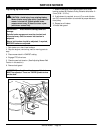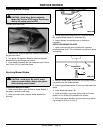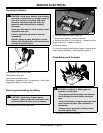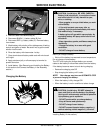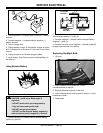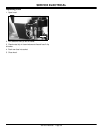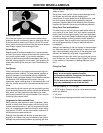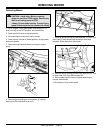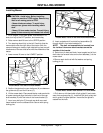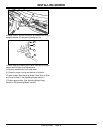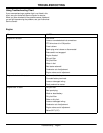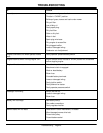
Service Miscellaneous - Page 41
SERVICE MISCELLANEOUS
Using Clean Fuels
Dirt in the fuel system is a major cause of performance
problems. Be sure to clean any grass or trash from the top
of the tank before removing lid. Use of a PLASTIC funnel
with a plastic mesh strainer when filling the tank will prevent
most foreign material from entering the tank.
Octane Rating
Regular grade 87 octane unleaded fuel is recommended
for use in your tractor. Higher octane fuels will seldom make
your tractor perform better. If your tractor develops a
starting or performance problem immediately after use of
new fuel, change supplier or fuel brand. If the problem still
exists after switching fuel, see your John Deere dealer for
service.
Fuel Blends
Fuels are blended to give peak performance during cold
weather and warm weather. For cold weather, gasoline is
specially blended to provide better starting capabilities.
However, avoid prolonged storage of cold-weather blended
fuel because it will evaporate more quickly. You may
experience longer cranking times in cold weather with “old”
fuel. Buy smaller amounts of cold-weather blended fuel in
winter.
Fuels used during the summer are not required to provide
improved starting properties so they are blended differently.
As a result, you may experience hard starting or other
performance problems during cold weather if you use fuel
remaining from summer uses.
Oxygenated or Reformulated Fuels
Many areas are now required to add “oxygenates” (either
alcohol or ether) which blend oxygen into the fuel to help
reduce exhaust emissions. If you use oxygenated fuel be
sure it is unleaded and meets the minimum octane rating
requirement. DO NOT use fuel that contains methanol to
avoid producing excess emissions.
Although fuels blended with alcohol or ether allow your
engine to run cleaner, they may contribute to fuel system
damage and performance problems by causing gum and
varnish deposits, especially if fuel is stored for several
weeks or more.
Using clean, fresh fuel will help to prevent damage to the
fuel system and will help maintain peak engine
performance. If engine performance problems occur, use
fuel from another supplier before suspecting machine
problems. Suppliers blend fuels differently and changing
suppliers will generally solve any performance problems.
Using Fresh Fuel and Stabilizers
The best thing you can do to ensure peak performance of
your engine is to use “fresh” fuel. Your tractor’s engine will
perform well with most good-quality fresh fuels regardless
of additives. Any fuel will begin to deteriorate and evaporate
over time and begin to form gum and varnish deposits in
the fuel system. Help to avoid this by buying only enough
fuel to last approximately 30 days or add fuel stabilizer
immediately.
Adding a fuel stabilizer to the fuel system is recommended
any time the tractor will not be operated for more than 60
days. Varnish deposits may build up in the carburetor in as
little as a few weeks by using stale, oxygenated fuel.
No stabilizer will work with “stale” fuel, any fuel that is more
than 30 days old. (See Preparing Your Engine For Storage
in this section for information on adding stabilizer to the
fuel.)
Filling Fuel Tank
Fuel tank capacity: 4.7 L (1.25 gal).
1. STOP engine. If engine is hot let it cool several minutes
before you add fuel.
2. Lift hood.
3. Remove grass clippings and other trash from tank area.
IMPORTANT: Avoid machine damage. Dirt and
water in fuel are major causes of engine
performance problems. Prevent dirt and debris from
entering the fuel tank when filling.
Fillthetankattheendofeachday’soperationto
help keep condensation out of the fuel tank.



